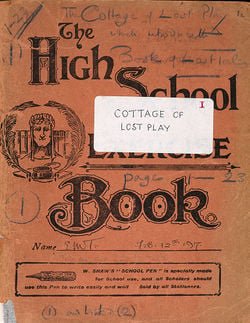History of Middle-Earth, Part 1 – The Birth of a Legendarium

Tolkien Before Middle-Earth
When we speak of J.R.R. Tolkien today, we think of him as the father of modern fantasy, the creator of Middle-Earth, and the author who gave us hobbits, elves, and the grand struggle against the Dark Lord. But before he became a literary giant, he was simply John Ronald Reuel Tolkien—born in 1892, a brilliant student of languages, and a man whose personal journey would shape one of the most extraordinary mythologies ever written.
Tolkien’s early life was marked by both promise and loss. His father died when he was only four, and his mother, who nurtured his love of words, languages, and myths, passed away while he was still a teenager. Left an orphan, Tolkien’s refuge was in language itself—he invented entire tongues before he had even entered university. At Oxford, he flourished as a philologist, but soon the world would be torn apart by the First World War, and Tolkien, like many of his generation, was pulled into its horrors.
The Great War and the First Stories
In 1916, Tolkien found himself in the trenches of the Somme, one of the bloodiest battles in history. He was only 24, recently married, and watching his closest friends from school fall one by one. The mud, the filth, the mechanized slaughter—it all left a mark that could not be erased. He contracted trench fever and was shipped back to England to recover.

And it was during those long days of convalescence, notebook at his side, that he began writing the first stories of what he would later call his legendarium. On the cover of one of his early school exercise books, we read the words The Cottage of Lost Play. It was the beginning of what would eventually become The Book of Lost Tales, the seed from which Middle-Earth grew. At this point there were no hobbits, no Frodo or Sam. Instead, these were mythic tales: the Music of the Ainur, the making of the Sun and Moon, the hidden lands of Valinor, and the fall of great Elvish kingdoms.
Building a Legendarium
Over the decades, Tolkien continued to build upon this world. He wrote and rewrote stories, created elaborate histories, and drafted languages with their own grammars and scripts. To read his unpublished manuscripts is to walk through layer after layer of invention. Tales begin one way and shift into something new in later versions. Characters evolve, sometimes changing names or roles entirely. Whole continents are redrawn.
It is less like reading a finished epic and more like watching a mythology being discovered in real time. Tolkien was not only writing stories; he was constructing a mythology for England, one he believed his homeland lacked.
Christopher Tolkien’s Stewardship
This brings us to The History of Middle-Earth, the monumental 13-volume series that documents this creative process. Officially, it has 12 volumes, but I count 13, because The Nature of Middle-Earth—edited by Carl F. Hostetter after Christopher Tolkien’s passing—belongs to the set. Together, they form nearly 5,000 pages of drafts, notes, poems, annals, and essays.
None of this would have been possible without Christopher Tolkien. After his father’s death in 1973, Christopher inherited a mountain of unfinished manuscripts—thousands of pages written in a hand that was often difficult even for family to decipher. For decades, he devoted himself to editing, organizing, and publishing his father’s work. He was not merely an editor but an interpreter, carefully piecing together fragments and providing commentary to guide readers through the labyrinth of drafts. Without Christopher, we would have no Silmarillion, no Unfinished Tales, and certainly no History of Middle-Earth.
Three Arcs of the History
The History of Middle-Earth is best understood in three arcs:
- Before The Lord of the Rings – the first five volumes cover Tolkien’s earliest myths, from 1915 through the 1930s.
- During The Lord of the Rings – volumes six through nine reveal how a simple “hobbit sequel” evolved into an epic saga.
- After The Lord of the Rings – volumes ten through twelve (and now thirteen) contain Tolkien’s late-life writings: philosophical explorations of creation, evil, mortality, and time.
This structure helps readers make sense of the sprawling series, showing how Tolkien’s imagination shifted across different periods of his life.
Why It Matters
What makes the History of Middle-Earth so fascinating is precisely its unfinished, exploratory quality. Reading it is not like reading a novel; it is like peering over Tolkien’s shoulder as he drafts, scratches out, and redrafts again.
We see how characters like Tinúviel (later Lúthien) first appear in one form and transform over decades. We watch the city of Gondolin imagined and reimagined. We trace the rise and fall of Númenor across multiple versions, each closer to the Atlantis-like story Tolkien sought to tell. In these volumes, the process itself becomes the story.
The Journey Ahead
As we embark on this six-part journey, we are not simply recounting tales of Elves and Men, of dark lords and lost kingdoms. We are tracing the evolution of a myth-maker, a man who, in the wake of war and loss, sought to give meaning and beauty through storytelling.
Over the next five weeks, we will dive into each of the 13 volumes—exploring the early myths, the shaping of the Silmarillion, the drafts of The Lord of the Rings, and the philosophical depth of Tolkien’s later writings.
Middle-Earth did not spring fully formed from Tolkien’s mind. It was built, stone by stone, word by word, over a lifetime. And through the History of Middle-Earth, we are invited not just to admire the finished architecture, but to walk through the scaffolding, to see the foundation stones, to witness the very act of creation itself.
This is the story behind the stories. And it begins, fittingly, in the mud of the Somme, with a young soldier’s dream of a mythology that would outlast both war and time.
Other posts in the series
- History of Middle-Earth, Part 1 – The Birth of a Legendarium
- History of Middle-Earth, Part 2 – The First Five Volumes: Early Myths & Lost Tales
- History of Middle-Earth, Part 3 – The Road to Númenor and the Shaping of History
- History of Middle-Earth, Part 4 – The Making of The Lord of the Rings
- History of Middle-Earth, Part 5 – The Later Silmarillion
- History of Middle-Earth, Part 6 – Peoples and the Nature of Middle-Earth
Bibliography
- History of Middle Earth, Vol. 1: The Book of Lost Tales, Part I Kindle Paperback
- History of Middle Earth, Vol. 2: The Book of Lost Tales, Part II Kindle Paperback
- History of Middle Earth, Vol. 3: The Lays of Beleriand Kindle Paperback
- History of Middle Earth, Vol. 4: The Shaping of Middle-earth Kindle Paperback
- History of Middle Earth, Vol. 5: The Lost Road and Other Writings Kindle Paperback
- History of Middle Earth, Vol. 6: The Return of the Shadow Kindle Paperback
- History of Middle Earth, Vol. 7: The Treason of Isengard Kindle Paperback
- History of Middle Earth, Vol. 8: The War of the Ring Kindle Paperback
- History of Middle Earth, Vol. 9: Sauron Defeated Kindle Paperback
- History of Middle Earth, Vol. 10: Morgoth’s Ring Kindle Paperback
- History of Middle Earth, Vol. 11: The War of the Jewels Kindle Paperback
- History of Middle Earth, Vol. 12: The Peoples of Middle-earth Kindle Paperback
- History of Middle-Earth Index Paperback
- The Complete History of Middle-Earth Box Set Hardcover
- History of Middle-Earth Box Set#1 Hardcover
- History of Middle-Earth Box Set#2 Hardcover
- History of Middle-Earth Box Set#3 Hardcover
- History of Middle-Earth Box Set#4 Hardcover
- The Nature of Middle-Earth Kindle Paperback Hardcover
👁️ 224 views


2 Comments on “History of Middle-Earth, Part 1 – The Birth of a Legendarium”
Interesting!
Thanks for visiting, Suraj.
Indeed, it is very interesting.
I haven’t read these books cover to cover, but I’ve often turned to it for reference.
The History of Middle-earth consists of 12 volumes, edited by J.R.R. Tolkien’s son, Christopher Tolkien.
I also consider The Nature of Middle-earth, published in 2021, to be the 13th volume. Though not edited by Christopher, it was compiled in the same spirit by Tolkien scholar Carl F. Hostetter, who, like Christopher, drew from J.R.R. Tolkien’s unpublished writings.